
Installations
Installations have been a part of my practice since my undergraduate years when I was inspired to recreate my mother’s altar and others I had seen in my childhood. Over the years, as a painter primarily, I created installations as spaces of integrity and context that my paintings could inhabit within the “white box” of a gallery/ exhibition space. These altars would explore the aesthetics of color, natural materials and numeric associations within Yoruba spirituality. In Puerto Rico this practice incorporated found and natural materials as political and spiritual signifiers, such as US military debris found on Vieques or sugarcane stalks. In more recent years with my work around bioluminescence, installations and painting directly on walls are an extension of the canvas, allowing the images to spill into the space. I envision CucubaNación, my Mayaguez art space that doubles as an intimate gallery of bioluminescence-inspired works and community space, as an immersive installation that allows visitors to feel as though they’ve stepped into a portal within which to contemplate this archipelagic womb, and the liberatory lessons of its bioluminescence.

“La Oposición Patriótica”, 2024. Yasmin Hernandez. Installation at la Casa Museo Filiberto Ojeda Ríos, Hormigueros, Puerto Rico. Afro.Bori.Libertaria, is part of la Alianza de Museos de Puerto Rico’s initiative Tiznando el país, celebrating Afro Boricua artists and themes in exhibitions across Puerto Rico. A collaboration between painters S. Damary Burgos and Yasmin Hernandez, Afro.Bori.Libertaria is a tribute to Afro Boricuas in our liberation struggle and a celebration of global African Liberation solidarities as inspired by the library collection of Filiberto Ojeda Ríos. This work recreates notes written by Filiberto towards his own defense while on trial. It is created in the colors of fireflies, the same colors of black liberation, and re-envisions the bullet blasts left on his wall by the FBI when he was assassinated on September 23rd, 2005.

“La Oposición Patriótica”, 2024. Yasmin Hernandez. Installation at la Casa Museo Filiberto Ojeda Ríos, Hormigueros, Puerto Rico. This work, recreating notes written by Filiberto towards his own defense while on trial, was installed in the space where Filiberto used to keep his generator. It is next to a narrow corridor whose posterior wall bears some of the most prominent bullet blasts left on his wall by the FBI when he was assassinated on September 23rd, 2005. These are replicated on the painting, rendered as the glowing spheres of fireflies, whose colors are the same colors of Black Liberation.
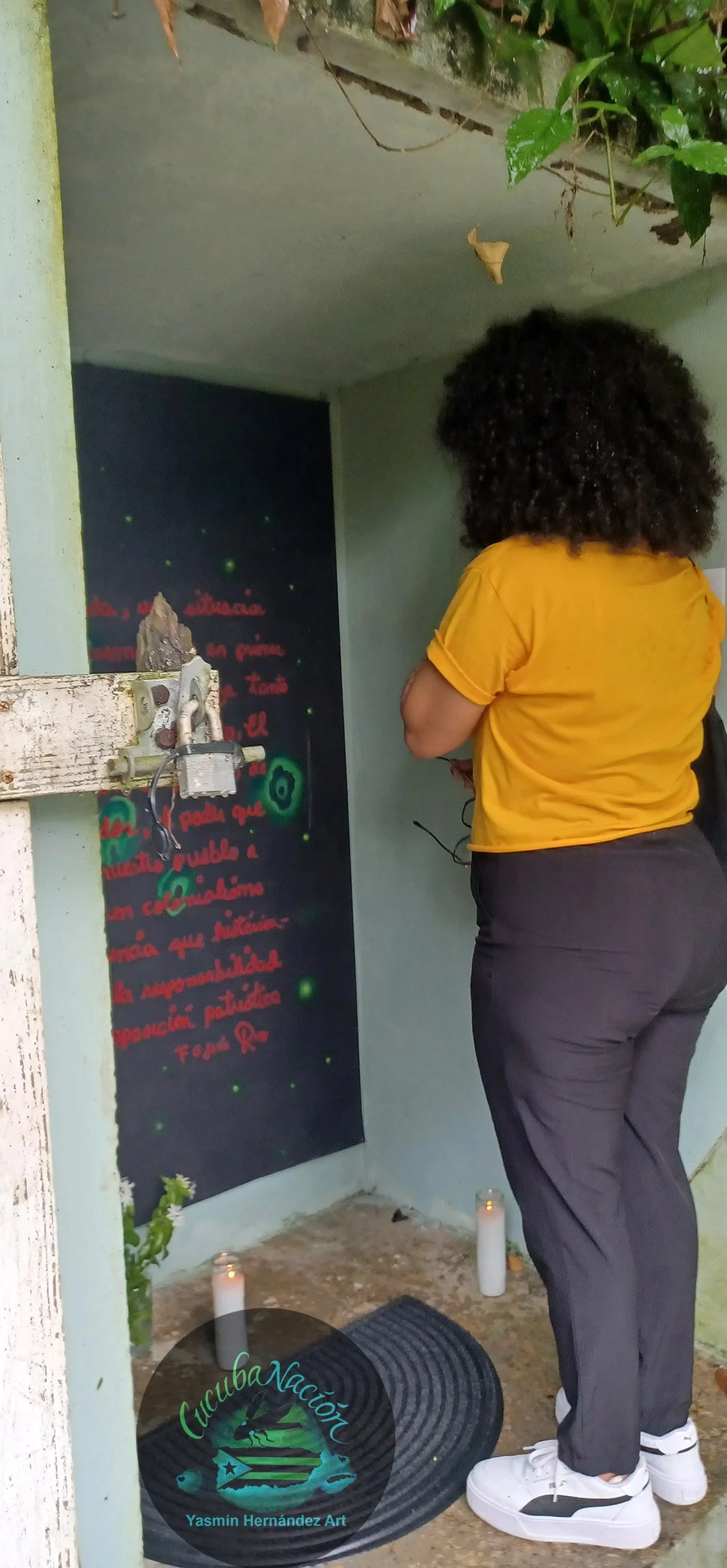
Janía with the installation “La Oposición Patriótica,” 2024, by Yasmin Hernandez. September 23rd, 2024, anniversary of el Grito de Lares and the assassination of Puerto Rican Freedom Fighter Filiberto Ojeda Ríos. Casa Museo Filiberto Ojeda Ríos, Hormigueros, Puerto Rico. Opening of the exhibition Afro.Bori.Libertaria, as part of la Alianza de Museos de Puerto Rico’s initiative Tiznando el país, celebrating Afro Boricua artists and themes in exhibitions across Puerto Rico. Afro.Bori.Libertaria, a collaboration between painters S. Damary Burgos and Yasmin Hernandez is a tribute to Afro Boricuas in our liberation struggle and a celebration of global African Liberation solidarities as inspired by the library collection of Filiberto Ojeda Ríos.
2023 view of "Portraits from the Trench" (Rematriation portraits) CucubaNación, Mayaguez, PR. Yasmin Hernandez. Portraits channeling abyss aesthetics.

"Portraits from the Trench" 2024. Yasmin Hernandez Art. Installation view at CucubaNación, Mayaguez, channeling abyss aesthetics and bioluminescence.

CucubaNación, Mayagüez, PR, 2022. Yasmin Hernandez. Opening exhibition of glowing portraits inspired by our bioluminescent bays to the left and fireflies and cucubanos to the right.

Cucubano and firefly-inspired paintings by Yasmin Hernandez at CucubaNación, Mayagüez, PR, created as an immersive installation in celebration of Boricua bioluminescence.

“Sobresalientes”, 2016. Galería Betances, Mayagüez, PR. Yasmin Hernandez Four acrylic paintings on camouflage fabric and her toddler sons' camouflage pants, size 3T and 4T, barbed wire, found wood. Approx 3' x 5'. Sobresalientes are images of Vieques youth and its environment, rising from the camouflage, leaving a military history behind.

Yasmin Hernandez and her Sobresalientes installation in 2016, Galería Betances, Mayagüez, PR.

“Esperanza,” 2016. Yasmin Hernandez. Bieké Sobresalientes series. Acrylic paint on my son's camouflage pants, size 3T. This image is of a little girl I once saw playing in Esperanza beach when I was six months pregnant with my first son and still researching for my Bieké project.
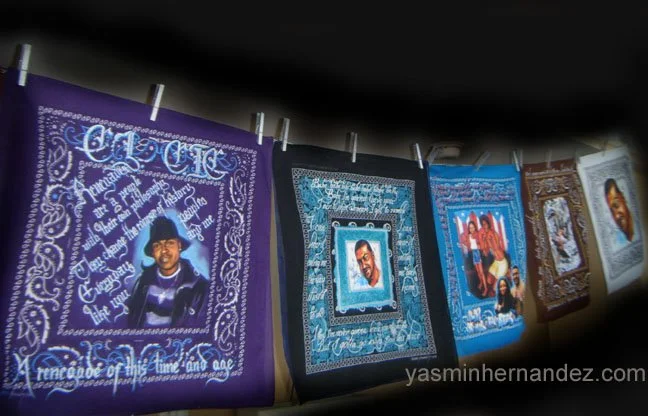
Detail, “Outlaw Clothesline.” Yasmin Hernandez. Nine mixed media paintings on cotton bandanas, 20" x 20" each, chrome chain, clothespins. The Outlaw Clothesline is an installation comprised of mixed media works on bandanas in memory of my brother Joseph Hernandez who ended his cancer battle in April of 2010. The bandanas piece together chapters of his life from beginning to end. The bandanas are intimate tribute to my brother's life, and to the Brooklyn of our youth.
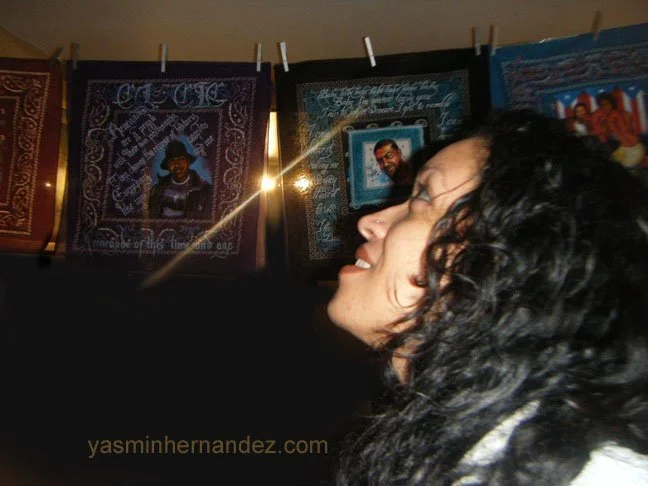
Yasmin Hernandez with the Outlaw Clothesline installation, 2014, New York City.
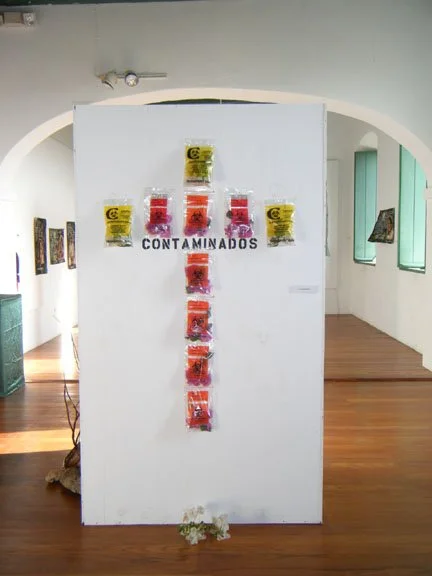
“Contaminados” 2010. Bieké series. Flower petals in 10 of my brother's former Chemotherapy drug transport bags, 7' x 4'. Museo Fuerte Conde de Mirasol, Vieques, Puerto Rico. This is a commentary on the contamination & cancer rates resulting from 60+ years of the US Navy's bomb practices on the Puerto Rican island of Vieques. Several of the people I had interviewed for my project were cancer survivors, or had lost loved ones to cancer. My brother was diagnosed back in NYC during one of my research trips to Vieques. He collected these bags in anticipation of this installation. He underwent a stem cell transplant during the exhibit's run & passed from cancer a week after the exhibit closed. Robert Rabin, director at El Museo Fuerte Conde de Mirasol who invited me to exhibit at the museum was too lost to cancer in 2022.

Detail, “Contaminados” 2009. Yasmin Hernandez. Flower petals in 10 of my brother's former Chemotherapy drug transport bags, 7' x 4'. Museo Fuerte Conde de Mirasol, Vieques, Puerto Rico. This is a commentary on the contamination & cancer rates resulting from 60+ years of the US Navy's bomb practices on the Puerto Rican island of Vieques. My brother in NYC collected these bags in anticipation of this installation. He underwent a stem cell transplant during the exhibit's run & passed from cancer a week after the exhibit closed.

Detail, “Contaminados” 2009. Yasmin Hernandez. Flower petals in 10 of my brother's former Chemotherapy drug transport bags, 7' x 4'. Museo Fuerte Conde de Mirasol, Vieques, Puerto Rico. This is a commentary on the contamination & cancer rates resulting from 60+ years of the US Navy's bomb practices on the Puerto Rican island of Vieques. My brother in NYC collected these bags in anticipation of this installation. He underwent a stem cell transplant during the exhibit's run & passed from cancer a week after the exhibit closed.

“Basta,” 2009. Yasmin Hernandez. Bieké: Tierra de Valientes series. Acrylic painting on military tent, Approx 10' x 8'. Chain link fencing, wire cutters and military debris. For this 2009 edition of my Basta installation, the fence is cut down as the people of Vieques did when they cut down the fences that demarcating civilian from occupied US military properties. The military items were collected by Vieques activist Robert Rabin in the former bombing range.

Detail of “Basta,” 2009. Yasmin Hernandez. Bieké: Tierra de Valientes series. Military debris collected by activist Robert Rabin in the US Navy's bombing range on Vieques.

"Cuando suena el caracol" 2008. Yasmin Hernandez. Installation at Taller Puertorriqueño, Inc., Philadelphia, PA. This work was originally created in 2006 for El Museo's Bienal: The (S) Files at el Museo de Arte de Puerto Rico. A tribute to our jibaro past and a reclamation of jibaro culture in the present, it includes a portrait of Julia de Burgos and singer Andrés Jiménez, “el Jíbaro,” as part of my Soul Rebels series honoring revolutionary poets and musicians.

“Yemaya,” 2007. Yasmin Hernandez. Installation view from gallery entrance. Museo Casa Escuté, Carolina, Puerto Rico. This was the seventh year since debuting my Yemaya installation in 2000. I retired it following this beautiful exhibit, Espirituales Afro, curated by Marta Moreno Vega and Marielba Torres.

Yemaya, 2007. Oil on Canvas, 4' x3', fabric, peacock feathers, seashells, sea stones, straw mat, flowers. Museo Casa Escuté, Carolina, Puerto Rico. Altar to Yoruba deity of motherhood and the sea, Yemaya.

“Yemaya,” 2007. Yasmin Hernandez. Oil on Canvas, 4' x3', fabric, peacock feathers, seashells, sea stones, straw mat, flowers. Museo Casa Escuté, Carolina, Puerto Rico. Altar to the Yoruba goddess of motherhood and the sea, Yemaya.

“Yemaya,” 2007. Yasmin Hernandez. Oil on Canvas, 4' x3', fabric, peacock feathers, seashells, sea stones, straw mat, flowers. Museo Casa Escuté, Carolina, Puerto Rico. Altar to the Yoruba goddess of motherhood and the sea, Yemaya.
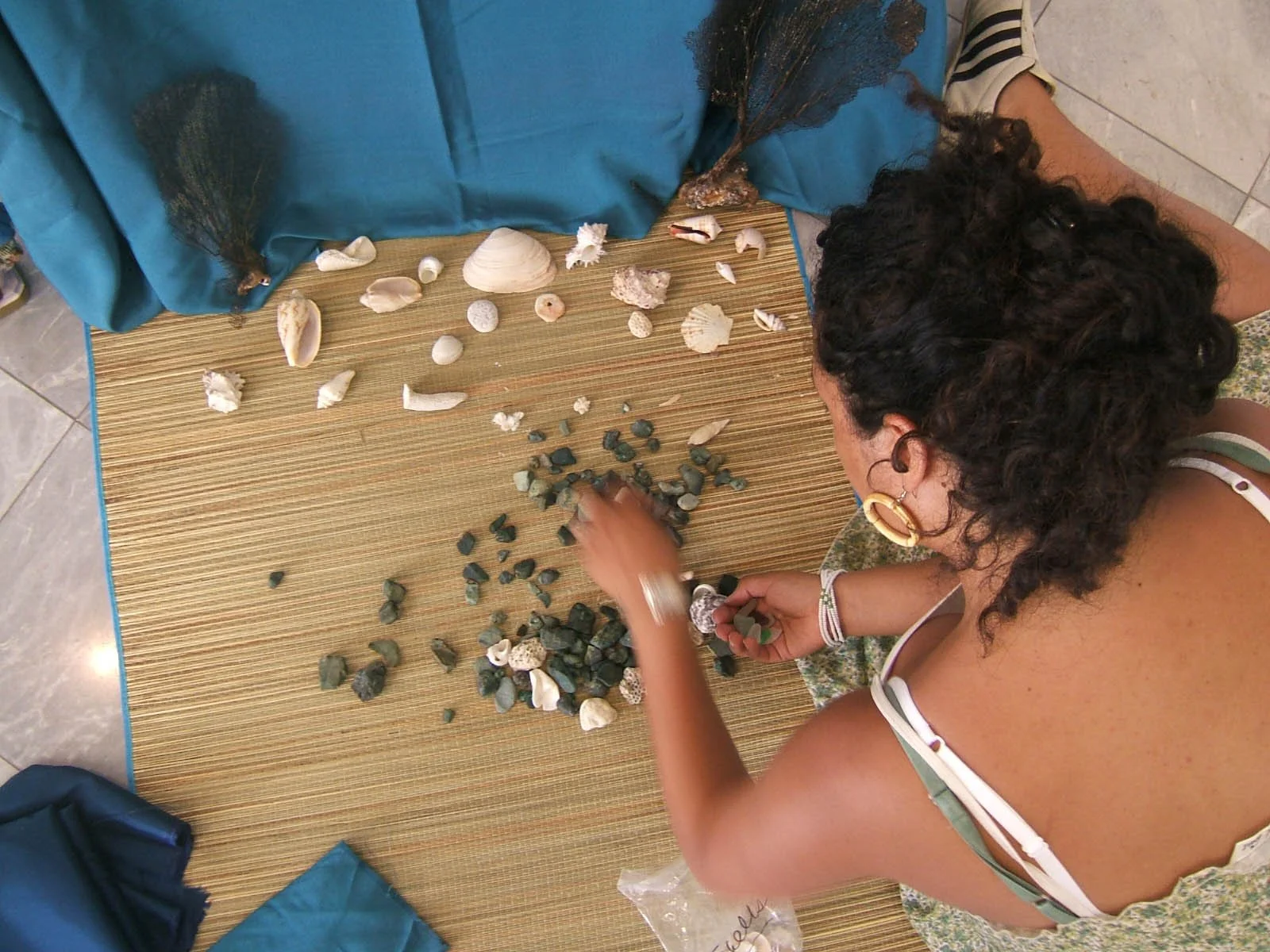
Yasmin organizing seashells and stones at Casa Escuté, Carolina, Puerto Rico, July, 2007. “Yemaya,” 2007. Yasmin Hernandez. Oil on Canvas, 4' x3', fabric, peacock feathers, seashells, sea stones, straw mat, flowers. Museo Casa Escuté, Carolina, Puerto Rico. Altar to the Yoruba goddess of motherhood and the sea, Yemaya.

“Basta,” 2007. Yasmin Hernandez. Bieké: Tierra de Valientes series. Acrylic painting on military tent, Approx 10' x 8'. Chain link fencing cage, razor wire, found objects, sand, seashells. The debut of this installation was created for The Field, an exhibition featuring a selection of artists from the registry at the Jamaica Center for Arts & Learning, curated by Heng-Gil Han. Dedicated to Vieques, the painting is of Yaurel Figueroa, who was 9 years old at the time. I met him with his dad and uncle at an encampment in Vieques protesting the intended privatization of a local beach. His parents are peace and environmental justice activists.

Fence detail. “Basta,” 2007. Yasmin Hernandez. Bieké: Tierra de Valientes series. Acrylic painting on military tent, Approx 10' x 8'. Chain link fencing cage, razor wire, found objects, sand, seashells. The debut of this installation was created for The Field, an exhibition featuring a selection of artists from the registry at the Jamaica Center for Arts & Learning, curated by Heng-Gil Han. Dedicated to Vieques, the painting is of Yaurel Figueroa, who was 9 years old at the time. I met him with his dad and uncle at an encampment in Vieques protesting the intended privatization of a local beach. His parents are peace and environmental justice activists.

Fence detail. “Basta,” 2007. Yasmin Hernandez. Bieké: Tierra de Valientes series. Acrylic painting on military tent, Approx 10' x 8'. Chain link fencing cage, razor wire, found objects, sand, seashells. The debut of this installation was created for The Field, an exhibition featuring a selection of artists from the registry at the Jamaica Center for Arts & Learning, curated by Heng-Gil Han. Dedicated to Vieques, the painting is of Yaurel Figueroa, who was 9 years old at the time. I met him with his dad and uncle at an encampment in Vieques protesting the intended privatization of a local beach. His parents are peace and environmental justice activists.

Sand detail. “Basta,” 2007. Yasmin Hernandez. Bieké: Tierra de Valientes series. Acrylic painting on military tent, Approx 10' x 8'. Chain link fencing cage, razor wire, found objects, sand, seashells. The debut of this installation was created for The Field, an exhibition featuring a selection of artists from the registry at the Jamaica Center for Arts & Learning, curated by Heng-Gil Han. Dedicated to Vieques, the painting is of Yaurel Figueroa, who was 9 years old at the time. I met him with his dad and uncle at an encampment in Vieques protesting the intended privatization of a local beach. His parents are peace and environmental justice activists.
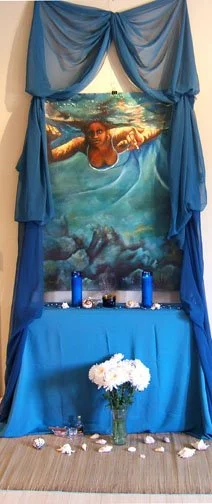
“Yemaya” 2006. Yasmin Hernandez. Installation, Yoruba Art exhibit, ISESE Gallery, Center for African and African American Studies, University of Texas at Austin.

“Miel de Abeja (Para Ochun)” 2006. Yoruba art exhibit, ISESE Gallery, Center for African and African American Studies, University of Texas, Austin.

"Cuando suena el caracol" 2006. Yasmin Hernandez. El Museo's Bienal: The (S) Files at el Museo de Arte de Puerto Rico. A tribute to our jibaro past and a reclamation of jibaro culture in the present, it includes a portrait of Julia de Burgos and singer Andrés Jiménez, “el Jíbaro,” as part of my Soul Rebels series honoring revolutionary poets and musicians. This was the first time I painted on burlap as a commentary on the declining agricultural production in Puerto Rico, burlap or “saco” being associated with those who work the land and with Babalu Aye, orisha who guides over the ill and the poor. Puerto Rico imports 85% of what it consumes because of colonialism and the monocrop corporate farming imposed by US corporations. Thankfully many more Boricuas are reclaiming the land and farming independently. The conch shell and title reference Guadalupe Hidalgo's song "Ven Buscame a Lares" which speaks of the 1868 revolution for independence.
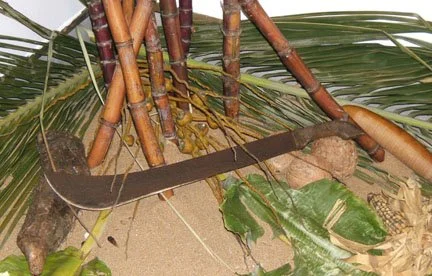
Detail, "Cuando suena el caracol" 2006. Yasmin Hernandez. El Museo's Bienal: The (S) Files at el Museo de Arte de Puerto Rico. A tribute to our jibaro past and a reclamation of jibaro culture in the present. Installation detail with sand, palms, banana leaf, machete, sugarcane, coconut, ñame, yuca, corn, higüera.

“Soul Rebels” 2005. Yasmin Hernandez. Installation as part of El Museo’s Bienal: The (S) Files. El Museo del Barrio, East Harlem, NYC. 8 mixed media panels on Masonite, 76 x 19”. The Soul Rebels installation was in the lobby of the Heckscher Building before el Museo del barrio underwent its capital project to transform the lobby area and entrance to the museum. “Soul Rebels” is borrowed from the Bob Marley song. The installation was on view from September 2005 through the end of 2006. It is a series of revolutionary poets and musicians of influence to the East and West Harlem communities. Photo: Sam Lahoz

Detail, Four of the Soul Rebels panels, L-R: Julia de Burgos, Piri Thomas, Eddie Palmieri, Pedro Pietri. “Soul Rebels” 2005. Yasmin Hernandez. Installation as part of el El Museo’s Bienal: The (S) Files. El Museo del Barrio, East Harlem, NYC. 8 mixed media panels on Masonite, 76 x 19”.
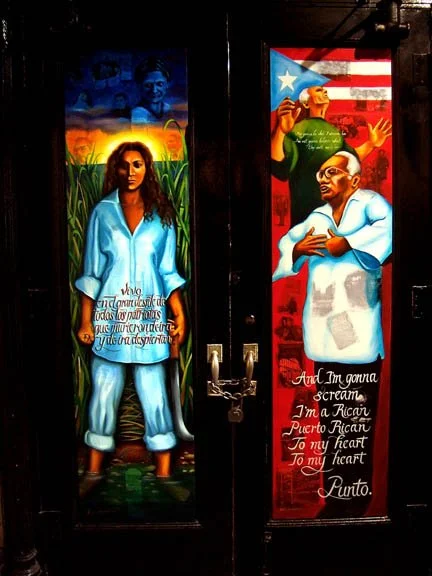
Detail of poet portraits "Despierta" (Soul Rebel: Julia de Burgos) and "Bright Puerto Rican Red" (Soul Rebel: Piri Thomas). “Soul Rebels” 2005. Yasmin Hernandez. Installation as part of el El Museo’s Bienal: The (S) Files. El Museo del Barrio, East Harlem, NYC. 8 mixed media panels on Masonite, 76 x 19”.

Yasmin Hernandez alongside her “Soul Rebels” panels of musicians Fela Kuti (Nigeria) and Bob Marley (Jamaica). Photo: John James. “Soul Rebels” 2005. Yasmin Hernandez. Installation as part of el El Museo’s Bienal: The (S) Files. El Museo del Barrio, East Harlem, NYC. 8 mixed media panels on Masonite, 76 x 19”.
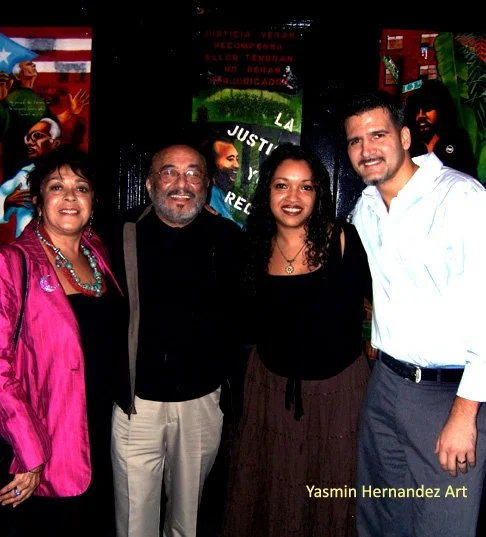
The first four panels were installed in time for the opening of El Museo's the (S) Files in 2005. The remaining four panels were installed in October of that year and so a separate reception was held. Our surprise guest of honor was featured Soul Rebel, legendary musician, Eddie Palmieri. Here my husband and I stand alongside Eddie and his portrait and my mentor, dear friend, now beloved ancestor, Puerto Rican Freedom Fighter Dylcia Pagan. Eternal gratitude to Young Lord Mickey Melendez for coordinating the visit from Eddie Palmieri! “Soul Rebels” 2005. Yasmin Hernandez. Installation as part of el El Museo’s Bienal: The (S) Files. El Museo del Barrio, East Harlem, NYC. 8 mixed media panels on Masonite, 76 x 19”.

“Mamita” 2004. Yasmin Hernandez. Mixed media installation at Patrias, Park Slope Brooklyn. Dedicated to my mother-in-law who passed from cancer in 2001. The altar includes traditional foods and artesanía from her native Colombia.

“Mamita” 2004. Yasmin Hernandez. Mixed media installation at Patrias, Park Slope Brooklyn. Dedicated to my mother-in-law who passed from cancer in 2001. The altar includes traditional foods and artesanía from her native Colombia.

Detail with candles, flowers, photos, chivitas, casitas, can of Colombiana, buñuelo, empanadas and pan de queso, favorites representing my mother-in-law's Colombian culture. “Mamita” 2004. Yasmin Hernandez. Mixed media installation at Patrias, Park Slope Brooklyn. Dedicated to my mother-in-law who passed from cancer in 2001. The altar includes traditional foods and artesanía from her native Colombia.

“Goddesses” 2003. Yasmin Hernandez. Installation at the 4th Encuentro, Hemispheric Institute of Performance and Politics. Kimmel Center, New York York University. New York, NY. This installation is a tribute to the divine feminine and to mothers. It and includes four portraits and altars of sister Yoruba goddesses Yemaya y Ochun and portraits of my mother and mother-in-law.
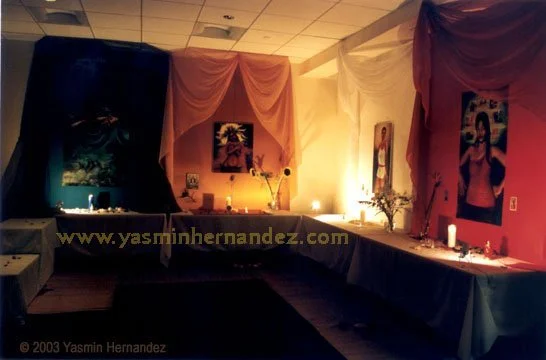
“Goddesses” 2003. Yasmin Hernandez. Installation at the 4th Encuentro, Hemispheric Institute of Performance and Politics. Kimmel Center, New York York University. New York, NY. This installation is a tribute to the divine feminine and to mothers. It and includes four portraits and altars of sister Yoruba goddesses Yemaya y Ochun and portraits of my mother and mother-in-law. detail, Yemaya and Oshun installations.

“Goddesses” 2003. Yasmin Hernandez. Installation at the 4th Encuentro, Hemispheric Institute of Performance and Politics. Kimmel Center, New York York University. New York, NY. This installation is a tribute to the divine feminine and to mothers. It and includes four portraits and altars of sister Yoruba goddesses Yemaya y Ochun and portraits of my mother and mother-in-law. detail, Yemaya and Oshun installations.

“Alma Boricua” 2000. Yasmin Hernandez. Installation at the Cornell Council for the Arts, Invitational Exhibition. Herbert F. Johnson Museum of Art, Cornell University, Ithaca, NY. This installation is a tribute and exploration of Boricua/ Caribbean heritage via our spirituality. In the center is the indigenous fertility goddess Atabey. At her sides are Yoruba goddess Yemaya, and La Virgen de Regla.
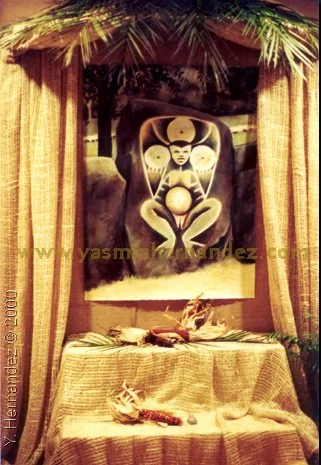
Bohío detail. “Alma Boricua” 2000. Yasmin Hernandez. Installation at the Cornell Council for the Arts, Invitational Exhibition. Herbert F. Johnson Museum of Art, Cornell University, Ithaca, NY. This installation is a tribute and exploration of Boricua/ Caribbean heritage via our spirituality. In the center is the indigenous fertility goddess Atabey. At her sides are Yoruba goddess Yemaya, and La Virgen de Regla.

“Yemaya Asesu” 1999. Yasmin Hernandez. Installation at the Onaní: The African Presence in Latin American Art at Taller Puertorriqueño, Inc. in Philadelphia. This was my first installation dedicated to Yoruba sea goddess Yemaya, created in collaboration with my cousin Omar. I experienced my first magic through art when the gallery flooded and created a sea, complete with waves on the sloping floor that crashed and receded into the sand at the foot of this installation.
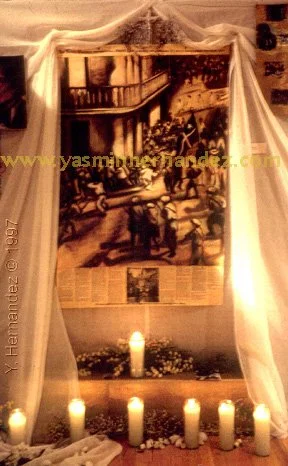
“Ponce Massacre” 1997, Yasmin Hernandez. Hartell Gallery. Cornell University. Oil/ collage on canvas, 51" x 34", fabric, flowers, candle. This first installation of The Ponce Massacre was part of my BFA Thesis project. The Ponce Massacre took place in 1937 Ponce, Puerto Rico, my parents' hometown. The US colonial police chief revoked a parade permit on Palm Sunday commemorating the abolition of slavery. When the people marched anyway, the police opened fire on them killing 21 and wounding around 200.
“La Oposición Patriótica”, 2024. Yasmin Hernandez. Installation at la Casa Museo Filiberto Ojeda Ríos, Hormigueros, Puerto Rico. Afro.Bori.Libertaria, is part of la Alianza de Museos de Puerto Rico’s initiative Tiznando el país, celebrating Afro Boricua artists and themes in exhibitions across Puerto Rico. A collaboration between painters S. Damary Burgos and Yasmin Hernandez, Afro.Bori.Libertaria is a tribute to Afro Boricuas in our liberation struggle and a celebration of global African Liberation solidarities as inspired by the library collection of Filiberto Ojeda Ríos. This work recreates notes written by Filiberto towards his own defense while on trial. It is created in the colors of fireflies, the same colors of black liberation, and re-envisions the bullet blasts left on his wall by the FBI when he was assassinated on September 23rd, 2005.
“La Oposición Patriótica”, 2024. Yasmin Hernandez. Installation at la Casa Museo Filiberto Ojeda Ríos, Hormigueros, Puerto Rico. This work, recreating notes written by Filiberto towards his own defense while on trial, was installed in the space where Filiberto used to keep his generator. It is next to a narrow corridor whose posterior wall bears some of the most prominent bullet blasts left on his wall by the FBI when he was assassinated on September 23rd, 2005. These are replicated on the painting, rendered as the glowing spheres of fireflies, whose colors are the same colors of Black Liberation.
Janía with the installation “La Oposición Patriótica,” 2024, by Yasmin Hernandez. September 23rd, 2024, anniversary of el Grito de Lares and the assassination of Puerto Rican Freedom Fighter Filiberto Ojeda Ríos. Casa Museo Filiberto Ojeda Ríos, Hormigueros, Puerto Rico. Opening of the exhibition Afro.Bori.Libertaria, as part of la Alianza de Museos de Puerto Rico’s initiative Tiznando el país, celebrating Afro Boricua artists and themes in exhibitions across Puerto Rico. Afro.Bori.Libertaria, a collaboration between painters S. Damary Burgos and Yasmin Hernandez is a tribute to Afro Boricuas in our liberation struggle and a celebration of global African Liberation solidarities as inspired by the library collection of Filiberto Ojeda Ríos.
2023 view of "Portraits from the Trench" (Rematriation portraits) CucubaNación, Mayaguez, PR. Yasmin Hernandez. Portraits channeling abyss aesthetics.
"Portraits from the Trench" 2024. Yasmin Hernandez Art. Installation view at CucubaNación, Mayaguez, channeling abyss aesthetics and bioluminescence.
CucubaNación, Mayagüez, PR, 2022. Yasmin Hernandez. Opening exhibition of glowing portraits inspired by our bioluminescent bays to the left and fireflies and cucubanos to the right.
Cucubano and firefly-inspired paintings by Yasmin Hernandez at CucubaNación, Mayagüez, PR, created as an immersive installation in celebration of Boricua bioluminescence.
“Sobresalientes”, 2016. Galería Betances, Mayagüez, PR. Yasmin Hernandez Four acrylic paintings on camouflage fabric and her toddler sons' camouflage pants, size 3T and 4T, barbed wire, found wood. Approx 3' x 5'. Sobresalientes are images of Vieques youth and its environment, rising from the camouflage, leaving a military history behind.
Yasmin Hernandez and her Sobresalientes installation in 2016, Galería Betances, Mayagüez, PR.
“Esperanza,” 2016. Yasmin Hernandez. Bieké Sobresalientes series. Acrylic paint on my son's camouflage pants, size 3T. This image is of a little girl I once saw playing in Esperanza beach when I was six months pregnant with my first son and still researching for my Bieké project.
Detail, “Outlaw Clothesline.” Yasmin Hernandez. Nine mixed media paintings on cotton bandanas, 20" x 20" each, chrome chain, clothespins. The Outlaw Clothesline is an installation comprised of mixed media works on bandanas in memory of my brother Joseph Hernandez who ended his cancer battle in April of 2010. The bandanas piece together chapters of his life from beginning to end. The bandanas are intimate tribute to my brother's life, and to the Brooklyn of our youth.
Yasmin Hernandez with the Outlaw Clothesline installation, 2014, New York City.
“Contaminados” 2010. Bieké series. Flower petals in 10 of my brother's former Chemotherapy drug transport bags, 7' x 4'. Museo Fuerte Conde de Mirasol, Vieques, Puerto Rico. This is a commentary on the contamination & cancer rates resulting from 60+ years of the US Navy's bomb practices on the Puerto Rican island of Vieques. Several of the people I had interviewed for my project were cancer survivors, or had lost loved ones to cancer. My brother was diagnosed back in NYC during one of my research trips to Vieques. He collected these bags in anticipation of this installation. He underwent a stem cell transplant during the exhibit's run & passed from cancer a week after the exhibit closed. Robert Rabin, director at El Museo Fuerte Conde de Mirasol who invited me to exhibit at the museum was too lost to cancer in 2022.
Detail, “Contaminados” 2009. Yasmin Hernandez. Flower petals in 10 of my brother's former Chemotherapy drug transport bags, 7' x 4'. Museo Fuerte Conde de Mirasol, Vieques, Puerto Rico. This is a commentary on the contamination & cancer rates resulting from 60+ years of the US Navy's bomb practices on the Puerto Rican island of Vieques. My brother in NYC collected these bags in anticipation of this installation. He underwent a stem cell transplant during the exhibit's run & passed from cancer a week after the exhibit closed.
Detail, “Contaminados” 2009. Yasmin Hernandez. Flower petals in 10 of my brother's former Chemotherapy drug transport bags, 7' x 4'. Museo Fuerte Conde de Mirasol, Vieques, Puerto Rico. This is a commentary on the contamination & cancer rates resulting from 60+ years of the US Navy's bomb practices on the Puerto Rican island of Vieques. My brother in NYC collected these bags in anticipation of this installation. He underwent a stem cell transplant during the exhibit's run & passed from cancer a week after the exhibit closed.
“Basta,” 2009. Yasmin Hernandez. Bieké: Tierra de Valientes series. Acrylic painting on military tent, Approx 10' x 8'. Chain link fencing, wire cutters and military debris. For this 2009 edition of my Basta installation, the fence is cut down as the people of Vieques did when they cut down the fences that demarcating civilian from occupied US military properties. The military items were collected by Vieques activist Robert Rabin in the former bombing range.
Detail of “Basta,” 2009. Yasmin Hernandez. Bieké: Tierra de Valientes series. Military debris collected by activist Robert Rabin in the US Navy's bombing range on Vieques.
"Cuando suena el caracol" 2008. Yasmin Hernandez. Installation at Taller Puertorriqueño, Inc., Philadelphia, PA. This work was originally created in 2006 for El Museo's Bienal: The (S) Files at el Museo de Arte de Puerto Rico. A tribute to our jibaro past and a reclamation of jibaro culture in the present, it includes a portrait of Julia de Burgos and singer Andrés Jiménez, “el Jíbaro,” as part of my Soul Rebels series honoring revolutionary poets and musicians.
“Yemaya,” 2007. Yasmin Hernandez. Installation view from gallery entrance. Museo Casa Escuté, Carolina, Puerto Rico. This was the seventh year since debuting my Yemaya installation in 2000. I retired it following this beautiful exhibit, Espirituales Afro, curated by Marta Moreno Vega and Marielba Torres.
Yemaya, 2007. Oil on Canvas, 4' x3', fabric, peacock feathers, seashells, sea stones, straw mat, flowers. Museo Casa Escuté, Carolina, Puerto Rico. Altar to Yoruba deity of motherhood and the sea, Yemaya.
“Yemaya,” 2007. Yasmin Hernandez. Oil on Canvas, 4' x3', fabric, peacock feathers, seashells, sea stones, straw mat, flowers. Museo Casa Escuté, Carolina, Puerto Rico. Altar to the Yoruba goddess of motherhood and the sea, Yemaya.
“Yemaya,” 2007. Yasmin Hernandez. Oil on Canvas, 4' x3', fabric, peacock feathers, seashells, sea stones, straw mat, flowers. Museo Casa Escuté, Carolina, Puerto Rico. Altar to the Yoruba goddess of motherhood and the sea, Yemaya.
Yasmin organizing seashells and stones at Casa Escuté, Carolina, Puerto Rico, July, 2007. “Yemaya,” 2007. Yasmin Hernandez. Oil on Canvas, 4' x3', fabric, peacock feathers, seashells, sea stones, straw mat, flowers. Museo Casa Escuté, Carolina, Puerto Rico. Altar to the Yoruba goddess of motherhood and the sea, Yemaya.
“Basta,” 2007. Yasmin Hernandez. Bieké: Tierra de Valientes series. Acrylic painting on military tent, Approx 10' x 8'. Chain link fencing cage, razor wire, found objects, sand, seashells. The debut of this installation was created for The Field, an exhibition featuring a selection of artists from the registry at the Jamaica Center for Arts & Learning, curated by Heng-Gil Han. Dedicated to Vieques, the painting is of Yaurel Figueroa, who was 9 years old at the time. I met him with his dad and uncle at an encampment in Vieques protesting the intended privatization of a local beach. His parents are peace and environmental justice activists.
Fence detail. “Basta,” 2007. Yasmin Hernandez. Bieké: Tierra de Valientes series. Acrylic painting on military tent, Approx 10' x 8'. Chain link fencing cage, razor wire, found objects, sand, seashells. The debut of this installation was created for The Field, an exhibition featuring a selection of artists from the registry at the Jamaica Center for Arts & Learning, curated by Heng-Gil Han. Dedicated to Vieques, the painting is of Yaurel Figueroa, who was 9 years old at the time. I met him with his dad and uncle at an encampment in Vieques protesting the intended privatization of a local beach. His parents are peace and environmental justice activists.
Fence detail. “Basta,” 2007. Yasmin Hernandez. Bieké: Tierra de Valientes series. Acrylic painting on military tent, Approx 10' x 8'. Chain link fencing cage, razor wire, found objects, sand, seashells. The debut of this installation was created for The Field, an exhibition featuring a selection of artists from the registry at the Jamaica Center for Arts & Learning, curated by Heng-Gil Han. Dedicated to Vieques, the painting is of Yaurel Figueroa, who was 9 years old at the time. I met him with his dad and uncle at an encampment in Vieques protesting the intended privatization of a local beach. His parents are peace and environmental justice activists.
Sand detail. “Basta,” 2007. Yasmin Hernandez. Bieké: Tierra de Valientes series. Acrylic painting on military tent, Approx 10' x 8'. Chain link fencing cage, razor wire, found objects, sand, seashells. The debut of this installation was created for The Field, an exhibition featuring a selection of artists from the registry at the Jamaica Center for Arts & Learning, curated by Heng-Gil Han. Dedicated to Vieques, the painting is of Yaurel Figueroa, who was 9 years old at the time. I met him with his dad and uncle at an encampment in Vieques protesting the intended privatization of a local beach. His parents are peace and environmental justice activists.
“Yemaya” 2006. Yasmin Hernandez. Installation, Yoruba Art exhibit, ISESE Gallery, Center for African and African American Studies, University of Texas at Austin.
“Miel de Abeja (Para Ochun)” 2006. Yoruba art exhibit, ISESE Gallery, Center for African and African American Studies, University of Texas, Austin.
"Cuando suena el caracol" 2006. Yasmin Hernandez. El Museo's Bienal: The (S) Files at el Museo de Arte de Puerto Rico. A tribute to our jibaro past and a reclamation of jibaro culture in the present, it includes a portrait of Julia de Burgos and singer Andrés Jiménez, “el Jíbaro,” as part of my Soul Rebels series honoring revolutionary poets and musicians. This was the first time I painted on burlap as a commentary on the declining agricultural production in Puerto Rico, burlap or “saco” being associated with those who work the land and with Babalu Aye, orisha who guides over the ill and the poor. Puerto Rico imports 85% of what it consumes because of colonialism and the monocrop corporate farming imposed by US corporations. Thankfully many more Boricuas are reclaiming the land and farming independently. The conch shell and title reference Guadalupe Hidalgo's song "Ven Buscame a Lares" which speaks of the 1868 revolution for independence.
Detail, "Cuando suena el caracol" 2006. Yasmin Hernandez. El Museo's Bienal: The (S) Files at el Museo de Arte de Puerto Rico. A tribute to our jibaro past and a reclamation of jibaro culture in the present. Installation detail with sand, palms, banana leaf, machete, sugarcane, coconut, ñame, yuca, corn, higüera.
“Soul Rebels” 2005. Yasmin Hernandez. Installation as part of El Museo’s Bienal: The (S) Files. El Museo del Barrio, East Harlem, NYC. 8 mixed media panels on Masonite, 76 x 19”. The Soul Rebels installation was in the lobby of the Heckscher Building before el Museo del barrio underwent its capital project to transform the lobby area and entrance to the museum. “Soul Rebels” is borrowed from the Bob Marley song. The installation was on view from September 2005 through the end of 2006. It is a series of revolutionary poets and musicians of influence to the East and West Harlem communities. Photo: Sam Lahoz
Detail, Four of the Soul Rebels panels, L-R: Julia de Burgos, Piri Thomas, Eddie Palmieri, Pedro Pietri. “Soul Rebels” 2005. Yasmin Hernandez. Installation as part of el El Museo’s Bienal: The (S) Files. El Museo del Barrio, East Harlem, NYC. 8 mixed media panels on Masonite, 76 x 19”.
Detail of poet portraits "Despierta" (Soul Rebel: Julia de Burgos) and "Bright Puerto Rican Red" (Soul Rebel: Piri Thomas). “Soul Rebels” 2005. Yasmin Hernandez. Installation as part of el El Museo’s Bienal: The (S) Files. El Museo del Barrio, East Harlem, NYC. 8 mixed media panels on Masonite, 76 x 19”.
Yasmin Hernandez alongside her “Soul Rebels” panels of musicians Fela Kuti (Nigeria) and Bob Marley (Jamaica). Photo: John James. “Soul Rebels” 2005. Yasmin Hernandez. Installation as part of el El Museo’s Bienal: The (S) Files. El Museo del Barrio, East Harlem, NYC. 8 mixed media panels on Masonite, 76 x 19”.
The first four panels were installed in time for the opening of El Museo's the (S) Files in 2005. The remaining four panels were installed in October of that year and so a separate reception was held. Our surprise guest of honor was featured Soul Rebel, legendary musician, Eddie Palmieri. Here my husband and I stand alongside Eddie and his portrait and my mentor, dear friend, now beloved ancestor, Puerto Rican Freedom Fighter Dylcia Pagan. Eternal gratitude to Young Lord Mickey Melendez for coordinating the visit from Eddie Palmieri! “Soul Rebels” 2005. Yasmin Hernandez. Installation as part of el El Museo’s Bienal: The (S) Files. El Museo del Barrio, East Harlem, NYC. 8 mixed media panels on Masonite, 76 x 19”.
“Mamita” 2004. Yasmin Hernandez. Mixed media installation at Patrias, Park Slope Brooklyn. Dedicated to my mother-in-law who passed from cancer in 2001. The altar includes traditional foods and artesanía from her native Colombia.
“Mamita” 2004. Yasmin Hernandez. Mixed media installation at Patrias, Park Slope Brooklyn. Dedicated to my mother-in-law who passed from cancer in 2001. The altar includes traditional foods and artesanía from her native Colombia.
Detail with candles, flowers, photos, chivitas, casitas, can of Colombiana, buñuelo, empanadas and pan de queso, favorites representing my mother-in-law's Colombian culture. “Mamita” 2004. Yasmin Hernandez. Mixed media installation at Patrias, Park Slope Brooklyn. Dedicated to my mother-in-law who passed from cancer in 2001. The altar includes traditional foods and artesanía from her native Colombia.
“Goddesses” 2003. Yasmin Hernandez. Installation at the 4th Encuentro, Hemispheric Institute of Performance and Politics. Kimmel Center, New York York University. New York, NY. This installation is a tribute to the divine feminine and to mothers. It and includes four portraits and altars of sister Yoruba goddesses Yemaya y Ochun and portraits of my mother and mother-in-law.
“Goddesses” 2003. Yasmin Hernandez. Installation at the 4th Encuentro, Hemispheric Institute of Performance and Politics. Kimmel Center, New York York University. New York, NY. This installation is a tribute to the divine feminine and to mothers. It and includes four portraits and altars of sister Yoruba goddesses Yemaya y Ochun and portraits of my mother and mother-in-law. detail, Yemaya and Oshun installations.
“Goddesses” 2003. Yasmin Hernandez. Installation at the 4th Encuentro, Hemispheric Institute of Performance and Politics. Kimmel Center, New York York University. New York, NY. This installation is a tribute to the divine feminine and to mothers. It and includes four portraits and altars of sister Yoruba goddesses Yemaya y Ochun and portraits of my mother and mother-in-law. detail, Yemaya and Oshun installations.
“Alma Boricua” 2000. Yasmin Hernandez. Installation at the Cornell Council for the Arts, Invitational Exhibition. Herbert F. Johnson Museum of Art, Cornell University, Ithaca, NY. This installation is a tribute and exploration of Boricua/ Caribbean heritage via our spirituality. In the center is the indigenous fertility goddess Atabey. At her sides are Yoruba goddess Yemaya, and La Virgen de Regla.
Bohío detail. “Alma Boricua” 2000. Yasmin Hernandez. Installation at the Cornell Council for the Arts, Invitational Exhibition. Herbert F. Johnson Museum of Art, Cornell University, Ithaca, NY. This installation is a tribute and exploration of Boricua/ Caribbean heritage via our spirituality. In the center is the indigenous fertility goddess Atabey. At her sides are Yoruba goddess Yemaya, and La Virgen de Regla.
“Yemaya Asesu” 1999. Yasmin Hernandez. Installation at the Onaní: The African Presence in Latin American Art at Taller Puertorriqueño, Inc. in Philadelphia. This was my first installation dedicated to Yoruba sea goddess Yemaya, created in collaboration with my cousin Omar. I experienced my first magic through art when the gallery flooded and created a sea, complete with waves on the sloping floor that crashed and receded into the sand at the foot of this installation.
“Ponce Massacre” 1997, Yasmin Hernandez. Hartell Gallery. Cornell University. Oil/ collage on canvas, 51" x 34", fabric, flowers, candle. This first installation of The Ponce Massacre was part of my BFA Thesis project. The Ponce Massacre took place in 1937 Ponce, Puerto Rico, my parents' hometown. The US colonial police chief revoked a parade permit on Palm Sunday commemorating the abolition of slavery. When the people marched anyway, the police opened fire on them killing 21 and wounding around 200.
